

Vol. 40 (Number 18) Year 2019. Page 4
PERUSQUIA, Juan Manuel Alberto 1 & RAMIREZ, Margarita 2
Received: 21/12/2018 • Approved: 18/05/2019 • Published 03/06/2019
ABSTRACT: Social entrepreneurship is a subject matter that is increasingly included in college curricula, as a standalone course as well as a dedicated topic in other courses such as entrepreneurship or business, government or social courses. This study tested hypotheses about predictors of social entrepreneurial intent among 630 members of the millennial generation from two countries: US and Mexico, as well as a mediator and three potential moderators (determinism, life satisfaction and concern for social problems). |
RESUMEN: El Empredurismo Social es un tema que se incluye cada vez más en los planes de estudios universitarios ya sea como un curso independiente o como un tema en otros cursos como emprendimiento o negocios, gobierno o cursos sociales. Este estudio probó hipótesis sobre predictores de intención del emprendimiento social entre 630 miembros de la generación milenial de dos países: Estados Unidos y México, así como un mediador y tres moderadores potenciales (determinación, satisfacción de vida y preocupación por problemas sociales). |
In order to understand the motivating factors underlying millennial intentions toward social entrepreneurship, a review was made on the subject and the characteristics of the millennial generation. Then potential antecedents drawing upon literature on social entrepreneurship, entrepreneurship, management education, and psychology were described.
In this sense, this paper aims to answer two major research questions:
And also proposes the following hypothesis:
While a unified definition of social entrepreneurship remains forthcoming, (Chell, 2007; Dees, Anderson & Wei-Skillern, 2004; Tracey & Phillips, 2007; Germak & Singh, 2010), social entrepreneurship can be understood as “a practice in which an entrepreneur – either a traditional business-minded individual or someone that emerges from the public or non-profit sectors – sets out to solve some social problem by way of combining business management skills with social sector acumen to yield a sustainable enterprise that produces both financial and social returns (a so-called double bottom line). In some cases, environmental returns may also be sought resulting in a so-called triple-bottom line.” (Germak & Robinson, 2013).
A social entrepreneur, then, is an individual who activate change in the social or profit sector by: adopting a mission to create and sustain social value (not just private value); recognizing and relentlessly pursuing new opportunities to serve that mission; engaging in a process of continuous innovation, adaptation, and learning; acting boldly without being limited by resources currently in hand, and exhibiting a heightened sense of accountability to the constituencies served and for the outcomes created (Dees, 1998, p. 4). Aldrich and Zimmer (1986) defined network as” the totality of all persons connected by a certain type of relationship.” They viewed entrepreneurship “embedded in the network of continuing social relations.” Social entrepreneurs start organizations designed to address a given social problem, join networks of people with similar concerns, and build their own networks, as needed, to mobilize people to action.
Krueger and Carsrud (1993) suggested that entrepreneurial intent is the “single best predictor” of subsequent entrepreneurial behavior. In other words, cognition precedes and predicts future behavior. The words of Ajzen (1991:181) provide insight: “Intentions are assumed to capture the motivational factors that influence a behavior; they are indications of how hard people are willing to try, of how much of an effort they are planning to exert in order to perform the behavior. As a general rule, the stronger the intent to engage in a behavior, the more likely should be its performance.” Given that the main aim of the study was to focus on “millennials,” (many of whom are just now being exposed to social entrepreneurship and are still too young to have actual experience as social entrepreneurs), we chose to study social entrepreneurial intent as opposed to social entrepreneurial behavior.
Hence the main dependent variable of the study is social entrepreneurial intent (SEI). We defined SEI for the purpose of the study as the intention to engage in social entrepreneurship within a given period of time (which we operationalized as within five years).
There is lively discussion in the SE literature as to what is the relative role in the SE intent and implementation of individual motivation versus the influence of the macro context (Mair, & Marti, 2006). Some studies question whether there is too much emphasis on the individual as prime mover in the SE and others giving primacy to the role of the individual in SE (Welter, Baker, Audretsch., & Gartner, 2017). One critique of this latter view is that there is perhaps an ethnocentric aspect where individualistic cultures, \such as the Anglo-Saxon culture, prioritizes the role of the individual.
This present research on SE motivation in a global context attempts to recognize and incorporate these differing perspectives by examining the individual’s SE motivation within a global context and thereby integrating the macro dimensions with individual’s motivation. The individual motivation can be captured, in part, by the individual’s belief that they have the ability to achieve goals. This belief is highly correlated with goal attainment (Bandura, 1977) and has been shown to be particularly relevant to entrepreneurial success (Chen, Greene, & Crick 1998).
Corporate social responsibility programs in the US remain the cornerstone for a large number of companies and startups, starting even to expand as a formula in which the origin, reason and main purpose seems to revolve around responsibility itself; creating among other things, in the business arena, a new type of entrepreneur.
These are the social entrepreneurs who, according to Ashoka (2018) itself, possess two outstanding attributes: an innovative idea that produces a significant social change and a entrepreneurship vision when it comes to execute their projects. They are individuals who possess the vision, creativity and determination traditionally associated with regular entrepreneurs, but their motivation is to generate deep and lasting social change, and not only the economic benefit.
Hence, social entrepreneurship could be framed around innovation, an area in which the United States is advantage situation over the world. And this is why the United States would be considered at the forefront in social entrepreneurship.
Social entrepreneurs in the United States are characterized by being individuals that recognize social problems and that are able to create, manage and develop an entrepreneurial project to generate social change; in their community, in their city, in their region, in their country and even in the world.
As these entrepreneurial projects grow, the social benefit multiplies. In the case of the United States, these projects have begun to cross borders, taking that multiplier of social benefit to other parts of the world. In this sense Ashoka (2018) itself states that currently there are projects that have reached several countries such as Mexico, Argentina, Peru, Venezuela and Colombia, in the case of Latin America.
However, the economic and social panorama itself, not only in the United States, but also in the world, presents a difficult prospect for the sustained growth of this type of projects. Therefore, it is necessary to work with social entrepreneurs to promote their organizations and overcome the barriers that may inhibit their development and consolidation. The question that arises now is how to achieve the viability of this type of project in such a complex context. Companies that look for the creation of economic and social value will than more likely face longer time to achieving economic sustainability through the market. First, because the people who create them normally place more emphasis on the creation of social value, and leave the economic matters in second place. Second, because entrepreneurs, generally being first timers, do not have much knowledge of the market. This makes economic viability take longer to achieve, and longer time to attain sustainability means more possibilities for failure.
Another key issue is the adaptive capacity of these companies to the current economic framework. The social entrepreneurs are individuals with a great capacity for innovation and adaptation to different contexts. Today in the United States the crisis has hit them like all companies; some have more capacity to resist, others are suffering difficulties. Now, these social entrepreneurs have a very important deterrent, they are generating innovation through the market, thus offering very interesting opportunities in different areas and achieving their own sustainability.
In Mexico, population growth, access to capital, government inefficiency and, in some cases, a disparity between supply and demand, among other things, have been key factors for the appearance and development of social entrepreneurs; nonetheless it is still an emerging trend in the entrepreneur sector.
According to Ashoka, México is starting to gain reputation as a hub for social entrepreneur projects (Ashoka, 2018). Even when at an early stage, the social-business approach has been growing steadily in Mexico in recent years. This is mainly because social entrepreneur projects pay close attention to social demand; trying to satisfy basic needs, left by the inefficiency of government and other entities; these social impact investments focus primarily in the lower, middle lower and middle class.
It then becomes clear that the development and expansion of this sector is critical in order to meet social demand at all levels and in order to do so this sector must be fed. Studies carried out by the Instituto Nacional del Emprendedor (National Entrepreneur Institute) show that education is crucial for the growth of this sector (INADEM, 2017). Social awareness and sensitization through Education at an early stage will help built up and strengthen social entrepreneurship human capital, promoting social entrepreneur culture and bolstering social innovation at the same time.
This makes sense when you take into account that 25.7% of Mexico´s population is between the ages of 15 to 29 years (INEGI, 2015) and most of this social business projects are carried out by young entrepreneurs, who have specific attitudes and aptitudes needed for the trade and developed at a very early stage of their life.
Even though education is a strategic element, other factors are also important in this equation such as securing adequate funding for this kind of projects; helping social enterprises gain access to markets, establish the appropriate fiscal and regulatory support frame to promote social entrepreneurship. In short, Mexico´s social entrepreneur ecosystem is still in a very early stage and therefore is in need of the appropriate environment for its proper growth and development; in which case youth plays not only an important but definite role.
Data was gathered from millennials in two countries and examined; direct effect by linear regression and indirect results by Hayes’ PROCESS version 3.0.
After verifying that the data distributed, the missing data was replaced by the averages of each country. Prior to testing hypotheses, it was verified that multicollinearity was not a severe problem that would preclude interpretation of the regression analyses (Neter, Wasserman, & Kutner, 1983).
The sample was comprised of university students of business administration from the US and Mexico. Students were selected as sample because the main focus of the study is millennial social entrepreneurial intent. Data was collected between 350 and 450 complete and valid responses at one university in each country, from which 315 responses were randomly selected from each country on 45 items, plus demographic data (age, sex, year in college, work experience, etc.). Females accounted for 327 respondents (51.90 %). Ages ranged between 15 and 38 years old (mean 24.4, std. dev. 3.90). Similar demographic differences among the respondents from each country were also found.
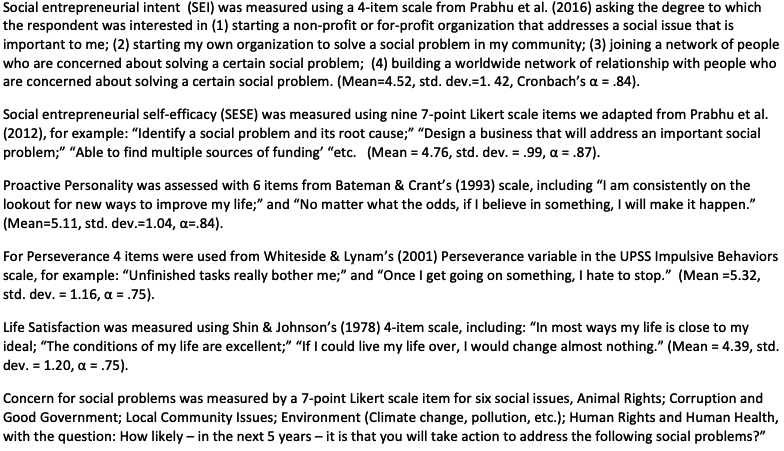
Table 1 reports descriptive statistics, reliabilities, and correlations for the overall sample, while Tables 2.1 to 2.2 report these statistics for each country.
Table 1
Overall Means, Reliabilities, and Correlations between Variables
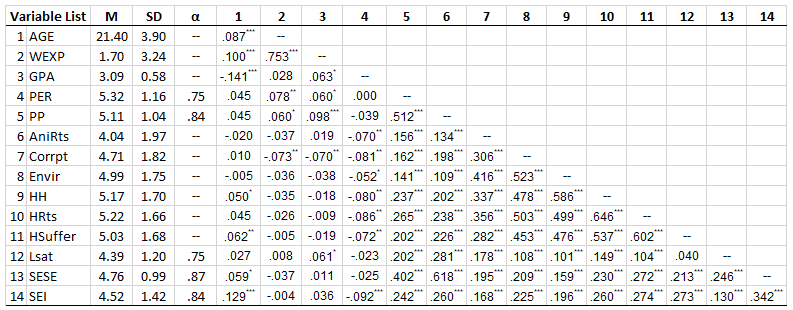
Note: * p<.05, ** p<.01, *** p<.001 N=1762
The data for this study was collected anonymously. Anonymity provided benefits by potentially reducing the method bias (see Podsakoff, MacKenzie, Lee, & Podsakoff, 2003).
Table 2.1.
Mexican Sample Means, Reliabilities, and Correlations between Variables
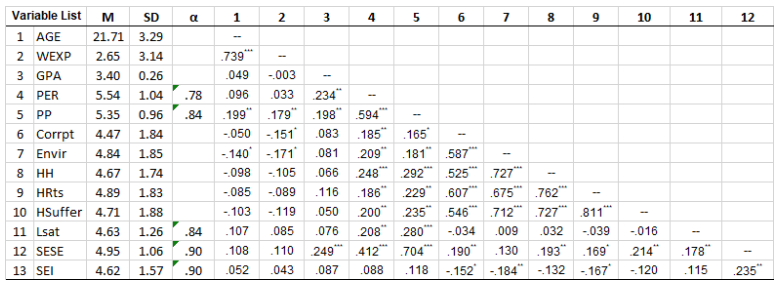
Note: * p<.05, ** p<.01, *** p<.001 N=210 Table
-----
2.2.
U.S. Sample Means, Reliabilities, and Correlations between Variables
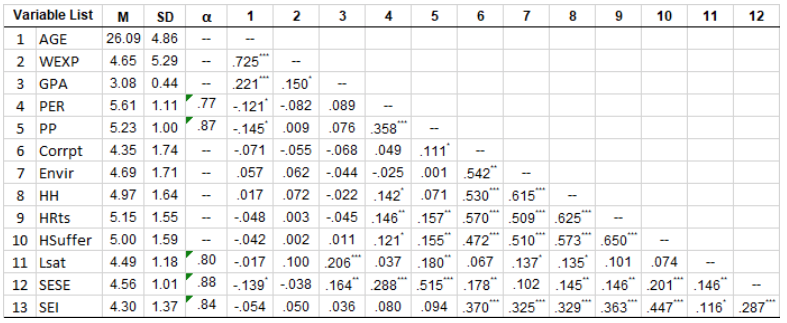
Data was analyzed using Structural Equation Modeling (SEM) implemented in AMOS (Arbuckle, 2006a; 2006b). First the model fit was tested using several confirmatory factor analyses and comparing the goodness of fit indices. SEM was used to validate the conceptual model.
After verifying that the data were normally distributed, we replaced missing data by the averages of each country. Prior to testing hypotheses, we verified that multicollinearity was not a severe problem that would preclude interpretation of the regression analyses (Neter, Wasserman, & Kutner 1983).
The first hypothesis posited a direct relationship between the predictors (a) Concerns for social problems (CSP), (b) Perseverance (PER), Proactive Personality (PP), and the dependent variable, Social Entrepreneurial Intent (SEI), after controlling for birth order, age, work experience, and grade point average. Tables 3.1 to 3.2 report the results of multivariate regression tests of H1. In the two countries, between one and five of the five different social concerns were found to be direct predictors of SEI. In both the U.S. and Mexican Samples Concern for the Environment was found to be a direct antecedent of SEI. We also found that Perseverance and Proactive Personality were not direct predictors of SEI. We therefore found partial support for Hypothesis 1.
Table 3.1
Tests of Hypothesis 1, Mexican Sample Table 3.3. Tests of Hypothesis 1, Nigerian Sample
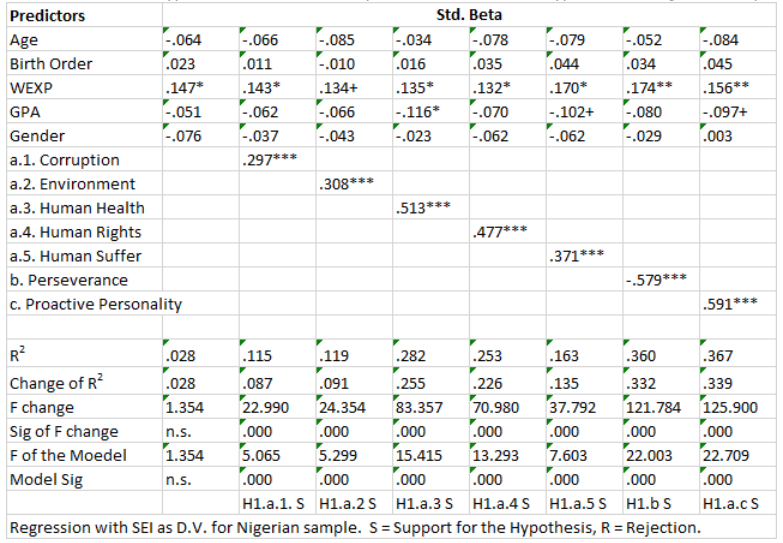
-----
Table 3.2
Tests of Hypothesis 1, U.S. Sample
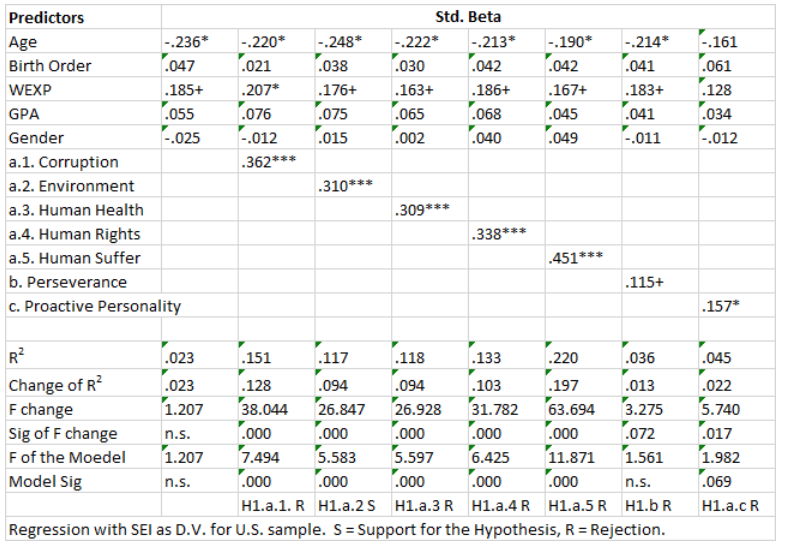
The second hypothesis posited that Social Entrepreneurial Self Efficacy (SESE) would mediate the relationship between (a) Concerns for Social Problems, (b) Perseverance, (c) Proactive Personality, and SEI.
Tables 4.1 to 4.2 provide the results of regression tests of mediation through SESE with Hayes’ Process (version 3.0).
Table 4.1
Tests of Hypothesis 2, Mexican Sample

**** < .001, ** < .01, * < .05, + < .10.
At the control of age, birth order, work experience, GPA, gender
90% confidence interval
H2 was supported in Mexican sample.
-----
Table 4.2
Tests of Hypothesis 2, U.S. Sample

**** < .001, ** < .01, * < .05, + < .10
At the control of age, birth order, work experience, GPA, gender
90% confidence interval
In both countries, we found that SESE fully or partially mediated the relationship between Perseverance and all five Concerns for Social Problems and SEI. Full mediation was found through SESE of the predictors in the two countries; which indicates that only the indirect effect of the predictor on SEI through SESE was significant.
We therefore found abundant support for Hypothesis 2.
This present study gives some insight into the commonalities and variations among the sample countries regarding the social entrepreneurship intention of millennial generation. Concern for social problems, perseverance, and proactive personality play important role among millennials for social entrepreneurship intent. It was interesting to see that there are some variations as to what specifics social concerns seem to drive SEI. Concern for the environment was the only real driver among the American and Mexican samples.
Self-efficacy is a major factor in the process of translating concern for social problems into SEI. In some cases, this self-efficacy was the driver, and other cases it was in combination with the proactive personality dimension. It is an interesting finding that Mexican and US youth have a similar pattern of motivation. Among the US and Mexican sample life satisfaction was a protector of SEI. This suggests that the American a Mexican millennials are pursuing SE from a place of abundance or satisfaction; at least from their point of view.
There are policy implications of this research. Training to improve SESE see would help millennials to pursue SE in the countries in our sample. It also suggests that government policy could look to seek those millennials with a high life satisfaction and should consider supporting their actions to consider Social Entrepreneurship as an option.
On the other hand, this research adds to the existing theory by integrating some individual attributes with the cultural context, thus linking individual differences theory with cross cultural comparative entrepreneurship literature.
Ajzen, I. (1991). The theory of planned behavior. Organizational Behavior and Human Decision Processes, 50, 179-211.
Aldrich, H. & Zimmer, C. (1986). Entrepreneurship through social networks. The art and science of entrepreneurship. Ballinger, Cambridge, MA, 3-23.
Ashoka Annual Report 2017/2018.
Ashoka México y Centroamérica 2018: Reporte Anual.
Bandura, A. (1977). Self-efficacy: toward a unifying theory of behavioral change. Psychological review, 84(2), 191.
Bateman, T.S., & Crant, J.M. (1993). The proactive component of organizational behavior: A measure and correlates. Journal of Organizational Behavior, 14, 103-118.
Crant, J. M., & Bateman, T. S. 2000. Charismatic leadership viewed from above: The impact of proactive personality. Journal of Organizational Behavior, 21, 63 – 75.
Chell, E. (2007). Social enterprise and entrepreneurship. International Small Business Journal, 25, 5-26.
Chen, C. C., Greene, P. G., & Crick, A. (1998). Does entrepreneurial self-efficacy distinguish entrepreneurs from managers? Journal of business venturing, 13(4), 295-316.
Dees, J.G. (1998). Enterprising non-profits. Harvard Business Review, 76(1), 54–65.
Dees, J.G., Anderson, B.B., & Wei-Skillern, J. (2004). Scaling social impact: Strategies for spreading social innovations. Stanford Social Innovation Review, 2 (Spring), 24–32.
Germak, A. J., and K. K. Singh. (2010). Social Entrepreneurship: Changing the Way Social Workers do Business. Administration in Social Work, 34 (1): 79–95
Germak, A. & Robinson, J. (2013). Exploring the Motivation of Nascent Social Entrepreneurs, Journal of Social Entrepreneurship, DOI: 10.1080/19420676.2013.820781
Instituto Nacional de Geografía y Estadística, 2017. Estadistica. http://www.inegi.org.mx
Instituto Nacional del Emprendedor, 2017. Informacion destacada. https://www.inadem.gob.mx
Krueger, N.F. & Carsrud, A.L. (1993). Entrepreneurial intentions: applying the theory of planned behavior. Entrepreneurship & Regional Development, 5, 315-330.
Mair, J. & Martí, I. (2006). Social entrepreneurship research: A source of explanation, prediction, and delight. Journal of World Business, 41(1), pp. 36-44.
Neter, J., Wasserman, W. & Kutner, M., (1983). Applied Linear Regression Models. R.D. Irwin, Publisher.
Podsakoff, P. M., MacKenzie, S. B., Lee, J. Y. & Podsakoff, N. P. (2003). Common method biases in behavioral research: a critical review of the literature and recommended remedies. Journal of applied psychology, 88, 879-903.
Prabhu, V. P., McGuire, S. J., Kwong, K. K., Zhang, Y., & Ilyinsky, A. (2016). Social entrepreneurship among millennials: A three-country comparative study. Australian Academy of Accounting and Finance Review, 2(4), 323-353.
Tracey, P. & Phillips, N. (2007). The distinctive challenge of educating social entrepreneurs: A postscript and rejoinder to the special issue on entrepreneurship education. Academy of Management Learning and Education, 6, 264-271.
Welter, F., Baker, T., Audretsch, D. B., & Gartner, W. B. (2017). Everyday entrepreneurship—a call for entrepreneurship research to embrace entrepreneurial diversity. Entrepreneurship, Theory and Practice. Vol 41, Issue 3, 2017
Whiteside, S.P. & Lynam, D.R. (2001). The five factor model and impulsivity: Using a structural model of personality to understand impulsivity. Personality and Individual Differences, 30, 669-689.
1. Ph.D in Administration. Professor-Researcher at the Faculty of Accounting and administration, Autonomous University of Baja California. Member of the National System of Researchers. perusquia@uabc.edu.mx
2. Ph.D in Strategic Planning. Professor-Researcher at the Faculty of Tourism and Marketing, Autonomous University of Baja California. Member of the National System of Researchers. mramirez@uabc.edu.mx